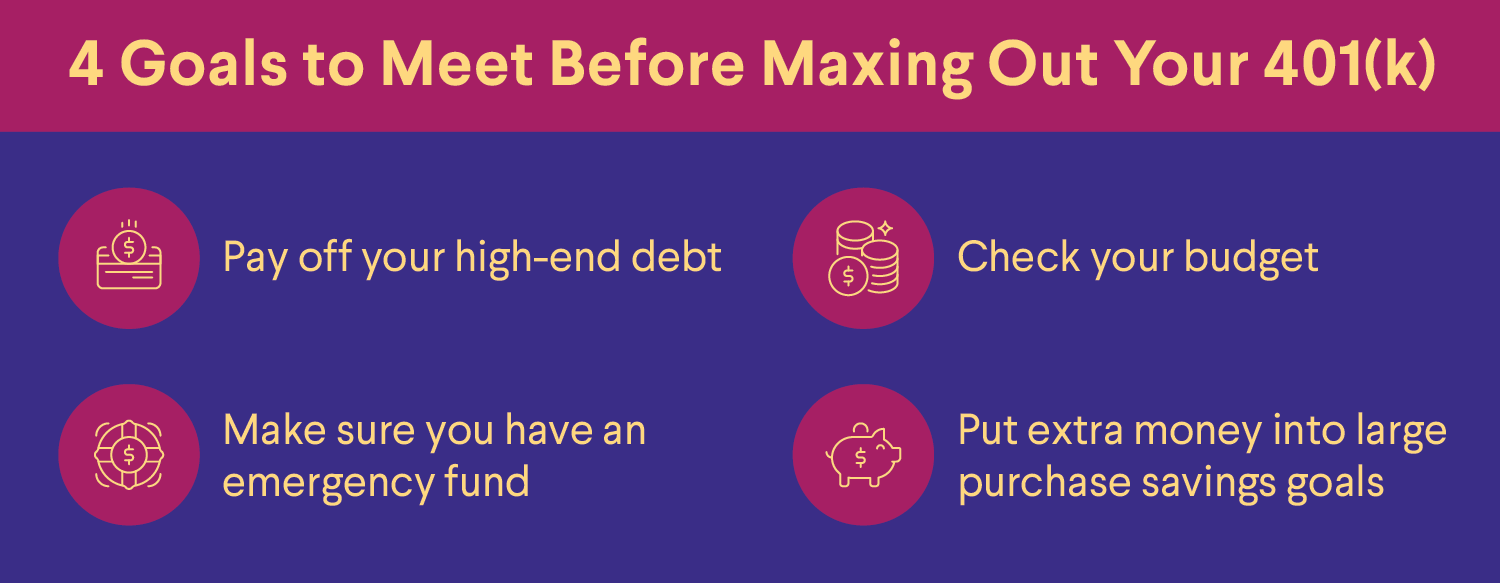Should I Put My Bonus Into My 401(k)? Here’s What You Should Consider
If you received a bonus and you’re wondering what to do with the bonus money, you’re not alone. Investing your bonus money in a tax-advantaged retirement account like a 401(k) has some tangible advantages. Not only will the extra cash help your nest egg to grow, you could also see some potential tax benefits.
Of course, we live in a world of competing financial priorities. You could also pay down debt, spend the money on something you need, save for a near-term goal — or splurge! The array of choices can be exciting — but if a secure future is your top goal, it’s important to consider a 401(k) bonus deferral.
Here are a few strategies to think about before you make a move.
Key Points
• Investing a bonus in a 401(k) can significantly enhance retirement savings and offer potential tax benefits.
• Bonuses are subject to income tax withholding, which may reduce the expected amount.
• Contribution limits for a 401(k) are $23,000 in 2024 and $23,500 in 2025 for those under age 50. Those aged 50 and over can make an additional catch-up contribution.
• If 401(k) contributions are maxed out, considering an IRA or a taxable brokerage account is beneficial.
• Allocating a bonus to a 401(k) or IRA can reduce taxable income for the year, potentially lowering the tax bill.
Receiving a Bonus Check
First, a practical reminder. When you get a bonus check, it may not be in the amount that you expected. This is because bonuses are subject to income tax withholding. Knowing how your bonus is taxed can help you understand how much you’ll end up with so you can determine what to do with the money that’s left, such as making a 401(k) bonus contribution. The IRS considers bonuses as supplemental wages rather than regular wages.
Ultimately, your employer decides how to treat tax withholding from your bonus. Employers may withhold 22% of your bonus to go toward federal income taxes. But some employers may add your whole bonus to your regular paycheck, and then tax the larger amount at normal income tax rates. If your bonus puts you in a higher tax bracket for that pay period, you may pay more than you expected in taxes.
Also, your bonus may come lumped in with your paycheck (not as a separate payout), which can be confusing.
Whatever the final amount is, or how it arrives, be sure to set aside the full amount while you weigh your options — otherwise you might be tempted to spend it.
💡 Quick Tip: Want to lower your taxable income? Start saving for retirement by opening an IRA account. The money you save each year in a traditional IRA is tax deductible (and you don’t owe any taxes until you withdraw the funds, usually in retirement).
What to Do With Bonus Money
There’s nothing wrong with spending some of your hard-earned bonus from your compensation. One rule of thumb is to set a percentage of every windfall (e.g. 10% or 20%) — whether a bonus or a birthday check — to spend, and save the rest.
To get the most out of a bonus, though, many people opt for a 401k bonus deferral and put some or all of it into their 401(k) account. The amount of your bonus you decide to put in depends on how much you’ve already contributed, and whether it makes sense from a tax perspective to make a 401(k) bonus contribution.
Contributing to a 401(k)
The contribution limit for 401(k) plans in 2024 is $23,000; for those 50 and older you can add another $7,500, for a total of $30,500. The contribution limit for 401(k) plans in 2025 is $23,500; for those 50 and older you can add another $7,500, for a total of $31,000. For 2025, those aged 60 to 63 may contribute an additional $11,250 (instead of $7,500), for a total of 34,750. If you haven’t reached the limit yet, allocating some of your bonus into your retirement plan can be a great way to boost your retirement savings.
In the case where you’ve already maxed out your 401(k) contributions, your bonus can also allow you to invest in an IRA or a non-retirement (i.e. taxable) brokerage account.
Contributing to an IRA
If you’ve maxed out your 401k contributions for the year, you may still be able to open a traditional tax-deferred IRA or a Roth IRA. It depends on your income.
In 2024, the contribution limit for traditional IRAs and Roth IRAs is $7,000; with an additional $1,000 if you’re 50 or older. In 2025, the contribution limit for traditional IRAs and Roth IRAs is also $7,000; with an additional $1,000 if you’re 50 or older.
However, if your income is $161,000 or more (for single filers) or $240,000 or more (for married filing jointly) in 2024, you aren’t eligible to contribute to a Roth. For 2025, you can’t contribute to a Roth if your income is $165,000 or more (for single filers) or $246,000 or more (for married filing jointly). And while a traditional IRA doesn’t have income limits, the picture changes if you’re covered by a workplace plan like a 401(k).
If you’re covered by a workplace retirement plan and your income is too high for a Roth, you likely wouldn’t be eligible to open a traditional, tax-deductible IRA either. You could however open a nondeductible IRA. To understand the difference, you may want to consult with a professional.
Get a 1% IRA match on rollovers and contributions.
Double down on your retirement goals with a 1% match on every dollar you roll over and contribute to a SoFi IRA.1
1Terms and conditions apply. Roll over a minimum of $20K to receive the 1% match offer. Matches on contributions are made up to the annual limits.
Contributing to a Taxable Account
Of course, when you’re weighing what to do with bonus money, you don’t want to leave out this important option: Opening a taxable account.
While employer-sponsored retirement accounts typically have some restrictions on what you can invest in, taxable brokerage accounts allow you to invest in a wider range of investments.
So if your 401(k) is maxed out, and an IRA isn’t an option for you, you can use your bonus to invest in stocks, bonds, exchange-traded funds (ETFs), mutual funds, and more in a taxable account.
Deferred Compensation
You also may be able to save some of your bonus from taxes by deferring compensation. This is when an employee’s compensation is withheld for distribution at a later date in order to provide future tax benefits.
In this scenario, you could set aside some of your compensation or bonus to be paid in the future. When you defer income, you still need to pay taxes later, at the time you receive your deferred income.
💡 Quick Tip: Did you know that opening a brokerage account typically doesn’t come with any setup costs? Often, the only requirement to open a brokerage account — aside from providing personal details — is making an initial deposit.
Your Bonus and 401(k) Tax Breaks
Wondering what to do with a bonus? It’s a smart question to ask. In order to maximize the value of your bonus, you want to make sure you reduce your taxes where you can.
One method that’s frequently used to reduce income taxes on a bonus is adding some of it into a tax-deferred retirement account like a 401(k) or traditional IRA. The amount of money you put into these accounts typically reduces your taxable income in the year that you deposit it.
Here’s how it works. The amount you contribute to a 401(k) or traditional IRA is tax deductible, meaning you can deduct the amount you save from your taxable income, often lowering your tax bill. (The same is not true for a Roth IRA or a Roth 401(k), where you make contributions on an after-tax basis.)
The annual contribution limits for each of these retirement accounts noted above may vary from year to year. Depending on the size of your bonus and how much you’ve already contributed to your retirement account for a particular year, you may be able to either put some or all of your bonus in a tax-deferred retirement account.
It’s important to keep track of how much you have already contributed to your retirement accounts because you don’t want to put in too much of your bonus and exceed the contribution limit. In the case where you have reached the contribution limit, you can put some of your bonus into other tax deferred accounts including a traditional IRA or a Roth IRA.
Recommended: Important Retirement Contribution Limits
How Investing Your Bonus Can Help Over Time
Investing your bonus may help increase its value over the long-run. As your money potentially grows in value over time, it can be used in many ways: You can stow part of it away for retirement, as an emergency fund, a down payment for a home, to pay outstanding debts, or another financial goal.
While it can be helpful to have some of your bonus in cash, your money is typically better in a savings or investment account where it has the potential to work for you. If you start investing your bonus each year in either a tax-deferred retirement account or non-retirement account, this could help you save for the future.
Test your understanding of what you just read.
Investing for Retirement With SoFi
The yearly question of what to do with a bonus is a common one. Just having that windfall allows for many financial opportunities, such as saving for immediate needs — or purchasing things you need now. But it may be wisest to use your bonus to boost your retirement nest egg — for the simple reason that you may stand to gain more financially down the road, while also potentially enjoying tax benefits in the present.
The fact is, most people don’t max out their 401(k) contributions each year, so if you’re in that boat it might make sense to take some or all of your bonus and max it out. If you have maxed out your 401(k), you still have options to save for the future via traditional or Roth IRAs, deferred compensation, or investing in a taxable account.
Keeping in mind the tax implications of where you invest can also help you allocate this extra money where it fits best with your plan.
Ready to invest for your retirement? It’s easy to get started when you open a traditional or Roth IRA with SoFi. SoFi doesn’t charge commissions, but other fees apply (full fee disclosure here).
FAQ
Is it good to put your bonus into a 401(k)?
The short answer is yes. It might be wise to put some or all of your bonus in your 401(k), depending on how much you’ve contributed to your workplace account already. You want to make sure you don’t exceed the 401(k) contribution limit.
How can I avoid paying tax on my bonus?
Your bonus will be taxed, but you can lower the amount of your taxable income by depositing some or all of it in a tax-deferred retirement account such as a 401(k) or IRA. However, this does not mean you will avoid paying taxes completely. Once you withdraw the money from these accounts in retirement, it will be subject to ordinary income tax.
Can I put all of my bonus into a 401(k)?
Possibly. You can put all of your bonus in your 401(k) if you haven’t reached the contribution limit for that particular year, and if you won’t surpass it by adding all of your bonus. For 2024, the contribution limit for a 401(k) is $23,000 if you’re younger than 50 years old; those 50 and over can contribute an additional $7,500 for a total of $30,500. In 2025, the contribution limit for a 401(k) is $23,500 if you’re under age 50, and those 50 and up can contribute an additional $7,500 for a total of $31,000. For 2025, those aged 60 to 63 may contribute an additional $11,250 instead of $7,500, thanks to SECURE 2.0.
You may also be interested in:
Photo credit: iStock/Tempura
Third-Party Brand Mentions: No brands, products, or companies mentioned are affiliated with SoFi, nor do they endorse or sponsor this article. Third-party trademarks referenced herein are property of their respective owners.
Financial Tips & Strategies: The tips provided on this website are of a general nature and do not take into account your specific objectives, financial situation, and needs. You should always consider their appropriateness given your own circumstances.
Tax Information: This article provides general background information only and is not intended to serve as legal or tax advice or as a substitute for legal counsel. You should consult your own attorney and/or tax advisor if you have a question requiring legal or tax advice.
SoFi Invest®
INVESTMENTS ARE NOT FDIC INSURED • ARE NOT BANK GUARANTEED • MAY LOSE VALUE
1) Automated Investing and advisory services are provided by SoFi Wealth LLC, an SEC-registered investment adviser (“SoFi Wealth“). Brokerage services are provided to SoFi Wealth LLC by SoFi Securities LLC.
2) Active Investing and brokerage services are provided by SoFi Securities LLC, Member FINRA (www.finra.org)/SIPC(www.sipc.org). Clearing and custody of all securities are provided by APEX Clearing Corporation.
For additional disclosures related to the SoFi Invest platforms described above please visit SoFi.com/legal.
Neither the Investment Advisor Representatives of SoFi Wealth, nor the Registered Representatives of SoFi Securities are compensated for the sale of any product or service sold through any SoFi Invest platform.
For a full listing of the fees associated with Sofi Invest please view our fee schedule.
Investment Risk: Diversification can help reduce some investment risk. It cannot guarantee profit, or fully protect in a down market.
Exchange Traded Funds (ETFs): Investors should carefully consider the information contained in the prospectus, which contains the Fund’s investment objectives, risks, charges, expenses, and other relevant information. You may obtain a prospectus from the Fund company’s website or by email customer service at https://sofi.app.link/investchat. Please read the prospectus carefully prior to investing.
Shares of ETFs must be bought and sold at market price, which can vary significantly from the Fund’s net asset value (NAV). Investment returns are subject to market volatility and shares may be worth more or less their original value when redeemed. The diversification of an ETF will not protect against loss. An ETF may not achieve its stated investment objective. Rebalancing and other activities within the fund may be subject to tax consequences.
SOIN0124066 Read more














